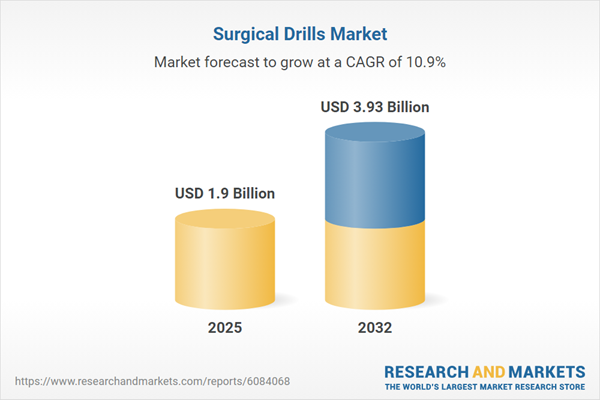Speak directly to the analyst to clarify any post sales queries you may have.
The surgical drills market is rapidly evolving, with advanced technologies and stringent regulations reshaping demand and adoption trends across global healthcare sectors. Senior decision-makers face complex choices in selecting high-performance, cost-effective drilling solutions that align with shifting clinical, operational, and policy environments.
Market Snapshot: Understanding the Surgical Drills Market Landscape
The surgical drills market grew from USD 1.71 billion in 2024 to USD 1.90 billion in 2025 and is projected to reach USD 3.93 billion by 2032, reflecting a CAGR of 10.91%. This growth is powered by ongoing innovation in precision devices, rising demand for minimally invasive surgeries, and heightened investment from both public and private healthcare providers. The combination of new materials, engineering advances, and digital integration enhances reliability and patient outcomes while also supporting hospital efficiency.
Scope & Segmentation
This comprehensive report examines the global surgical drills market across key dimensions critical for strategic decision-making:
- Product Type: High-speed drills (including electric and pneumatic variants); low-speed drills (battery powered and mains powered); piezoelectric drills utilizing ultrasonic vibrations for minimally invasive procedures
- Technology: Corded and cordless options, enabling institutions to balance continuous power supply with operational flexibility
- Application: Dental, ENT, neurosurgery, and orthopedic fields, each demanding unique drilling performance and safety attributes
- End User: Ambulatory surgical centers, clinics (dental and specialty), as well as public and private hospitals with varying procedural needs
- Sales Channel: Traditional offline distribution alongside emerging online platforms supporting customizable procurement and rapid fulfillment
- Regions: Americas (with detailed coverage of the United States, Canada, Mexico, Brazil, Argentina, Chile, Colombia, and Peru); Europe, Middle East & Africa (encompassing key European, Middle Eastern, and African countries); Asia-Pacific (including China, India, Japan, Australia, South Korea, and major Southeast Asian markets)
- Key Companies: Stryker Corporation, DePuy Synthes, Zimmer Biomet Holdings, Medtronic, Smith & Nephew, B. Braun Melsungen, CONMED Corporation, Arthrex, Integra LifeSciences Holdings, NuVasive, and others actively shaping the competitive landscape
Surgical Drills Market: Key Takeaways
- Stakeholder priorities include integrating real-time feedback systems to reduce complications and streamline training for surgical staff.
- Adoption of minimally invasive drilling technologies is expanding, particularly in orthopedic and neurosurgical applications, as healthcare providers focus on improved recovery times and reduced infection risks.
- Value-based procurement models are driving buyers to assess total cost of ownership and long-term device performance rather than initial capital expenditure alone.
- Regulatory compliance pressures require manufacturers to maintain robust quality management systems, accelerating product development cycles and ensuring competitive differentiation.
- Partnerships between manufacturers, research institutions, and supply chain experts are fueling rapid innovation and expansion into new geographic and application areas.
Tariff Impact: Navigating Policy-Driven Cost Structures
New United States tariffs targeting imported medical device components are affecting manufacturers’ sourcing strategies and cost structures. Companies are exploring nearshoring options and alternative materials to offset input cost increases. Hospital procurement teams are renegotiating supply agreements to manage budget impacts, while industry collaborations aim to develop domestic alternatives that meet strict performance requirements. These changes present both operational challenges and opportunities for strategic repositioning in the supply chain.
Methodology & Data Sources
Our analysis leverages primary interviews with industry executives, surgeons, procurement leaders, and regulatory specialists, complemented by secondary research from technical publications, regulatory filings, and clinical studies. Rigorous data validation processes and collaborative expert reviews ensure the reliability of our insights and trend projections for the surgical drills market.
Why This Report Matters
- Equips decision-makers with actionable intelligence to optimize procurement and technology investment decisions amid regulatory changes and cost pressures.
- Supports business leaders in identifying segment-specific opportunities and emerging risks within diverse global markets for surgical drills.
- Facilitates strategic planning by providing a nuanced view of innovation, policy shifts, and competitive dynamics shaping future growth.
Conclusion
The surgical drills market is at a pivotal point where technological progress, regulatory strategies, and supply chain realignment converge. Senior leaders who leverage comprehensive market intelligence will be well-positioned to drive institutional growth and advance clinical excellence in this dynamic sector.
Table of Contents
3. Executive Summary
4. Market Overview
7. Cumulative Impact of Artificial Intelligence 2025
Companies Mentioned
The companies profiled in this Surgical Drills market report include:- Stryker Corporation
- DePuy Synthes, Inc.
- Zimmer Biomet Holdings, Inc.
- Medtronic plc
- Smith & Nephew plc
- B. Braun Melsungen AG
- CONMED Corporation
- Arthrex, Inc.
- Integra LifeSciences Holdings Corporation
- NuVasive, Inc.
Table Information
| Report Attribute | Details |
|---|---|
| No. of Pages | 185 |
| Published | October 2025 |
| Forecast Period | 2025 - 2032 |
| Estimated Market Value ( USD | $ 1.9 Billion |
| Forecasted Market Value ( USD | $ 3.93 Billion |
| Compound Annual Growth Rate | 10.9% |
| Regions Covered | Global |
| No. of Companies Mentioned | 11 |









